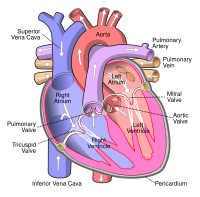
Photo from wikipedia
Congenital abnormalities of the systemic venous return (SVR) are rare, most often asymptomatic and discovered occasionally in the course of imaging studies. The persistence of the left superior vena cava… Click to show full abstract
Congenital abnormalities of the systemic venous return (SVR) are rare, most often asymptomatic and discovered occasionally in the course of imaging studies. The persistence of the left superior vena cava (PLSVC) is the most common thoracic venous anomaly. The prevalence is 0.1%–0.3% in the general population, more common in individuals with congenital heart anomalies (CHA). The PLSVC with the absence of the right superior vena cava (ARSVC) is extremely rare, with a prevalence of 0.09% to 0.13% in patients with other CHA. The PLSVC is given by the persistence of the Marshall vein, counterpart of the superior vena cava in the early stages of embryonic development, which usually regresses during intrauterine development. The PLSVC determines venous return into the right atrium through the coronary sinus (CS), consequently dilated. Patients with abnormal SVR are at greater risk of developing arrhythmias due to possible aberrations in the cardiac conduction tissue in the early stages of development. In fact, the conduction tissue originates from two sites close to the superior vena cava ancestors. Furthermore, arrhythmias could result from structural abnormalities, such as right atrial dilation or CS dilation. We report the clinical case of M.C., female, premature of 33 weeks, birth weight 2450 g, APGAR score 8–9, silent prenatal history. On the second day of life, an echocardiography was performed, since a systolic murmur 1/6 in mesocardium was noticed. In addition to a restrictive interventricular muscle defect, the examination showed the PLSVC with a significant increase of the CS (5 mm), draining into the right atrium, and the ARSVC. During hospitalisation M.C. was subjected to electrocardiogram, oxygen saturation monitoring and heart rate, resulted in the normal ranges. M.C. was discharged on the 12th day of life in good general conditions with a cardiology follow up planned at 1 year of age.
Journal Title: Archives of Disease in Childhood
Year Published: 2017
Link to full text (if available)
Share on Social Media: Sign Up to like & get
recommendations!